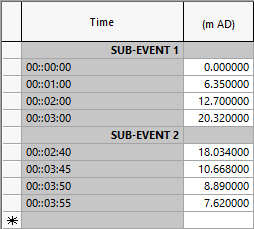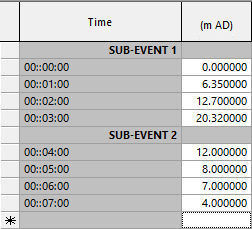Events
The data for simulations comes from events. An event contains a single set of hydrological or hydraulic data that varies with time, such as a rainfall record or, for InfoWorks networks, a prediction of domestic wastewater inflow.
The event types currently supported are:
- Rainfall - rainfall intensities for a particular storm and associated data:
- Initial conditions for runoff, water quality and snow data for InfoWorks networks.
- Temperature profiles. These are used for modelling snow melt and, in InfoWorks networks, they are also used when modelling runoff for subcatchments using the PDM runoff volume model
- Wind speed profile for use in modelling snow melt (InfoWorks networks only)
- Evaporation profiles to be applied to rainfall profiles
- Solar radiation profiles for use in modelling algae and coliform decay (InfoWorks networks only)
- Soil moisture deficit profiles for use when modelling runoff for subcatchments using the SRM runoff volume model (InfoWorks networks only)
- Level - level hydrographs applied to outfalls or 2D Boundaries
- Inflow - inflow hydrographs
- Pollutograph - In InfoWorks networks, a pollutogaph defines time varying pollutant and sediment concentration and potency profiles for inflows. In a SWMM network, a SWMM pollutograph defines the time-varying pollutant profile for an inflow.
In both types of networks, they are used in conjunction with an Inflow event that provides the underlying input discharges to the network. - Waste Water - 24-hour domestic wastewater profiles based on per capita flow (InfoWorks networks only)
- Trade Waste - 24-hour trade profiles (InfoWorks networks only)
- Ground Infiltration - time-varying infiltration values for groundwater storage level to be included in the Ground Infiltration Model (InfoWorks networks only)
- Regulator - time-varying profiles used to control regulator structures. In InfoWorks networks, these may be used in conjunction with RTC

Events cannot be used in simulations in conjunction with Time Series Database (TSDB) objects with the exception of Waste Water and Trade Waste events. However events can be imported into scalar time series databases.
Scalar TSDBs can be used in InfoWorks and SWMM networks while spatial TSDBs are only available for InfoWorks networks.
For details on creating and editing Events see the following topics:
Most events are made up of a series of sub-events and profiles.
Wastewater and Trade Waste events do not contain sub-events and profiles. They are a repeating 24 hour profile of per capita inflow from a population or point inflow from a trade source. This 24 hour profile can vary between weekdays and weekends, and can be scaled with a monthly multiplier.
Sub-events
Most events contain one or more sub-events. A sub-event is a single occurrence that can be isolated in time.
When a simulation is performed for an InfoWorks network, the engine used to process the simulation treats sub-events as follows:
- if the simulation starts before the first sub-event, values for earlier timesteps are set to zero
- if the simulation continues beyond the last timestep of the last sub-event, the value for any subsequent timesteps is set to zero
- if the simulation covers a gap between two sub-events:
- for all events with the exception of rainfall events - ICM interpolates linearly between the last value in one sub-event and the first value in the next to generate intermediate values. If you want all values between sub-events to be zero (or a fixed number), make the last timestep in one sub-event and the first timestep of the next equal to zero (or your chosen number)
- for rainfall events only - Values between sub-events are automatically set to zero by ICM
When sub-events for rainfall events in SWMM simulations are processed by its simulation engine, they are treated as follows:
- if the simulation starts before the first sub-event, values for earlier timesteps are set to zero
- if the simulation continues beyond the last timestep of the last sub-event, the value for any subsequent timesteps is set to zero
- if the simulation covers a gap between two sub-events, the values between sub-events are automatically set to zero by ICM
For events, other than rainfall events, the engine that is used for processing SWMM simulations treats all the times in the event, regardless of any division into sub-events, as a constant stream of data. Therefore, each sub-event time must be specified in ascending order, and no sub-event can have overlapping times.
Each sub-event has its own parameters, which can be viewed and edited on the appropriate Sub-Event Properties Dialog. Open this dialog by right clicking on the sub-event data and choosing Sub-Event Properties from the popup menu.
Profiles
A sub-event is made up of one or more profiles. A profile is a series of time-varying data values applicable to a particular measurement point. Each profile contains a number of timesteps, with data for each timestep. The profile defines a set of characteristics for the data. These include the shape of the data, the intensity of the peak and the position of the peak within the data as a whole. For example, the profile for a summer storm may describe a brief period of intense rainfall, where a high peak is reached very soon after the onset of the storm, with the rainfall dying away very quickly after the peak has passed.
A profile may contain theoretical data (such as the characteristics of a standard storm) or recorded data (for instance, the results from a rain gauge). A single event may contain several profiles: for example, the profiles for a series of storms or the recorded data from a number of gauges in a catchment.
Each profile has its own set of parameters for each sub-event. For example, if an event has two sub-events, each profile will have two sets of parameters, one for each sub-event. These parameters can be viewed and edited on the appropriate Profile Properties dialog. Open this dialog by right clicking on the profile data within the chosen sub-event and choosing Profile Properties from the popup menu.
Although each profile has an independent set of parameters for each sub-event, there are some parameters, such as the point at which the profile is linked to the network during a simulation, that should be the same for all sub-events. See the Profile Properties Dialog topic for more information.



